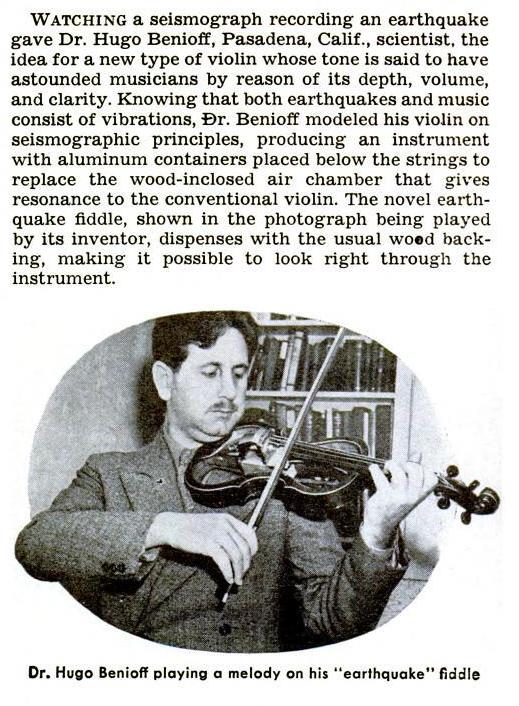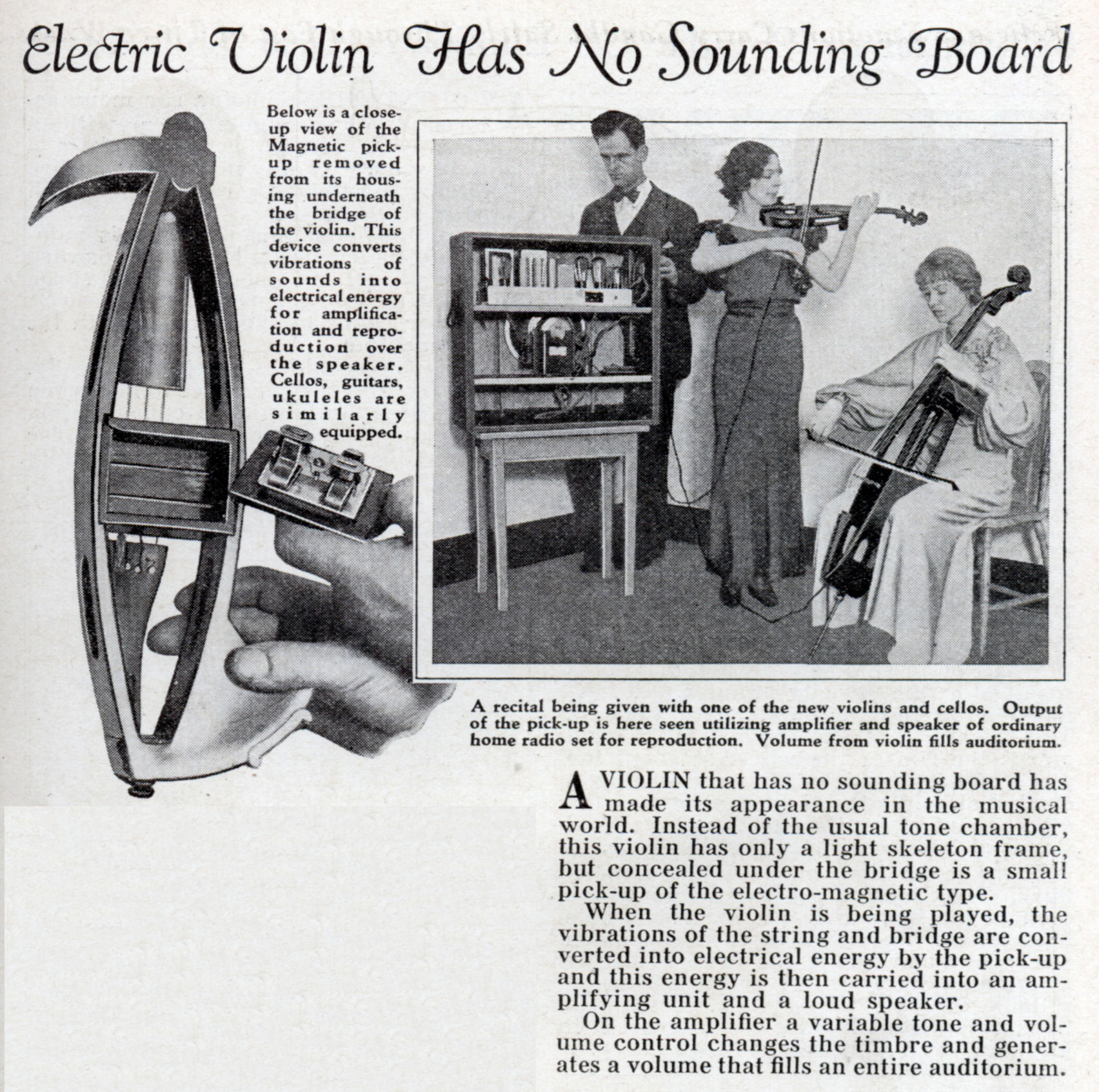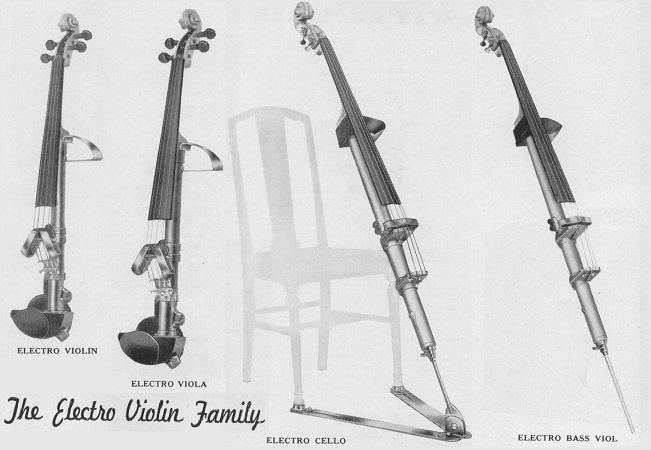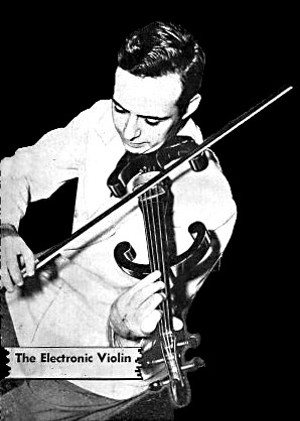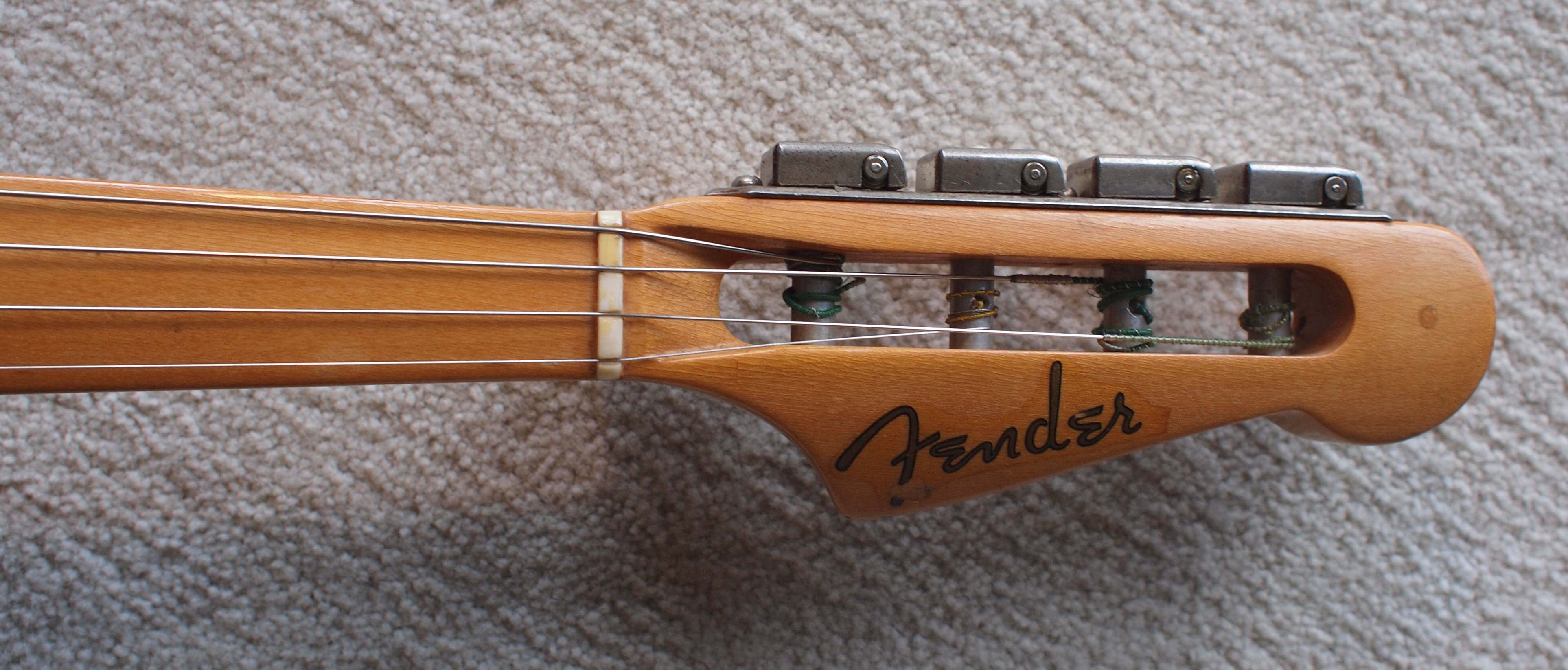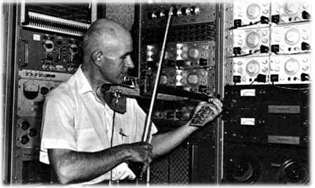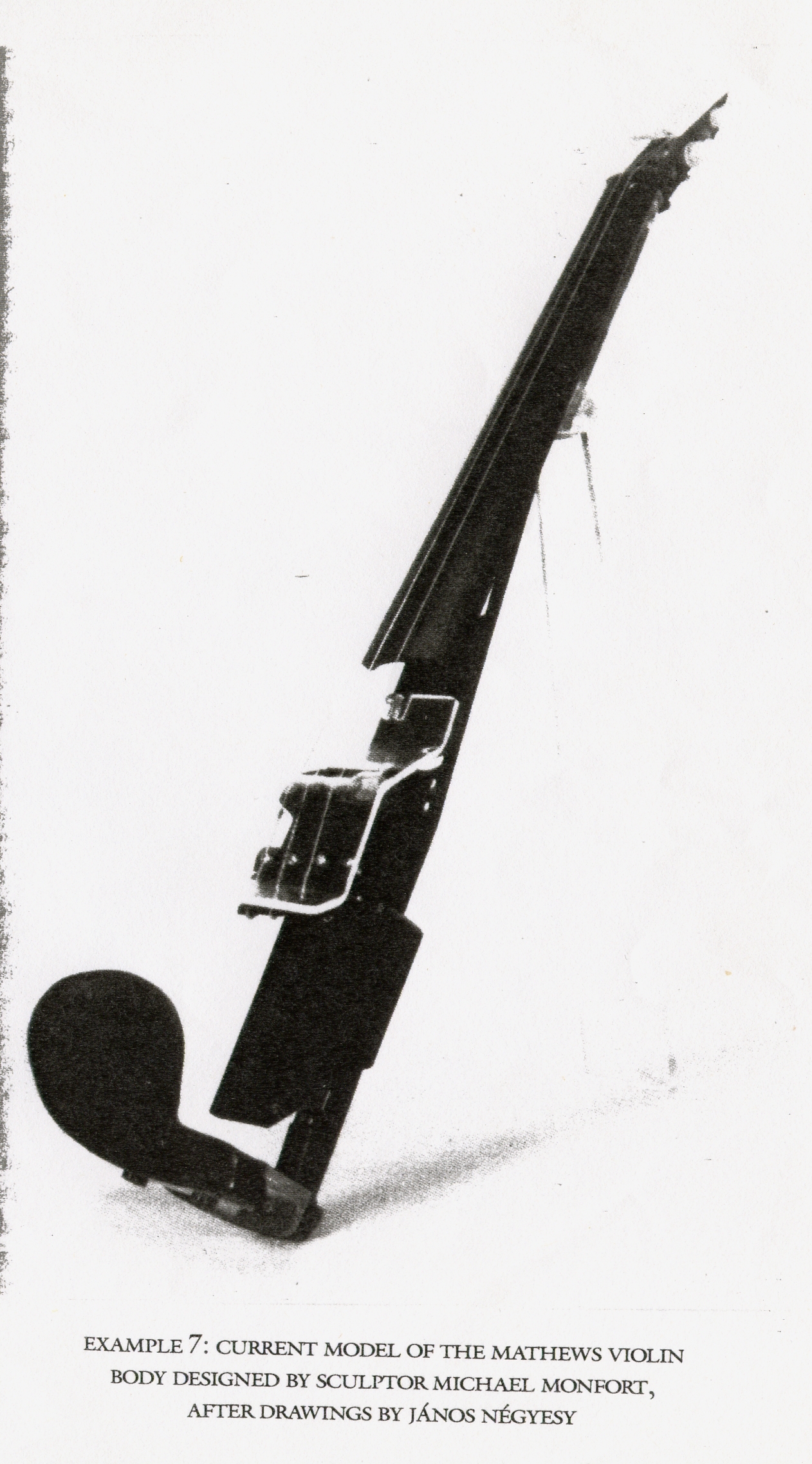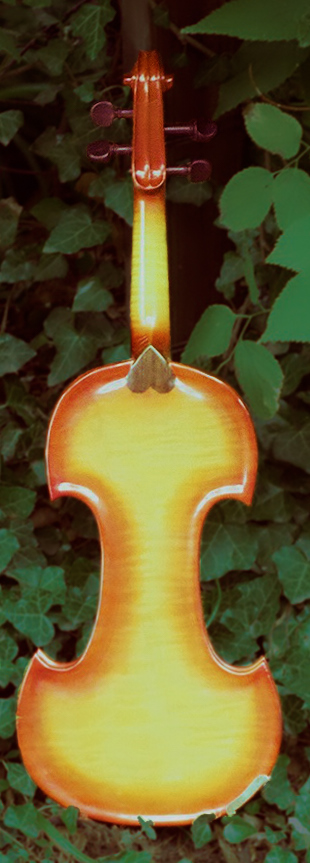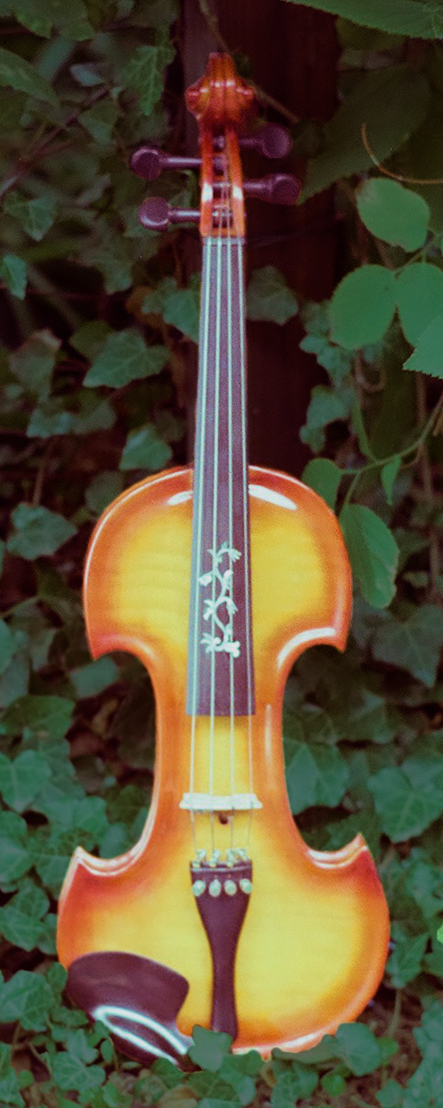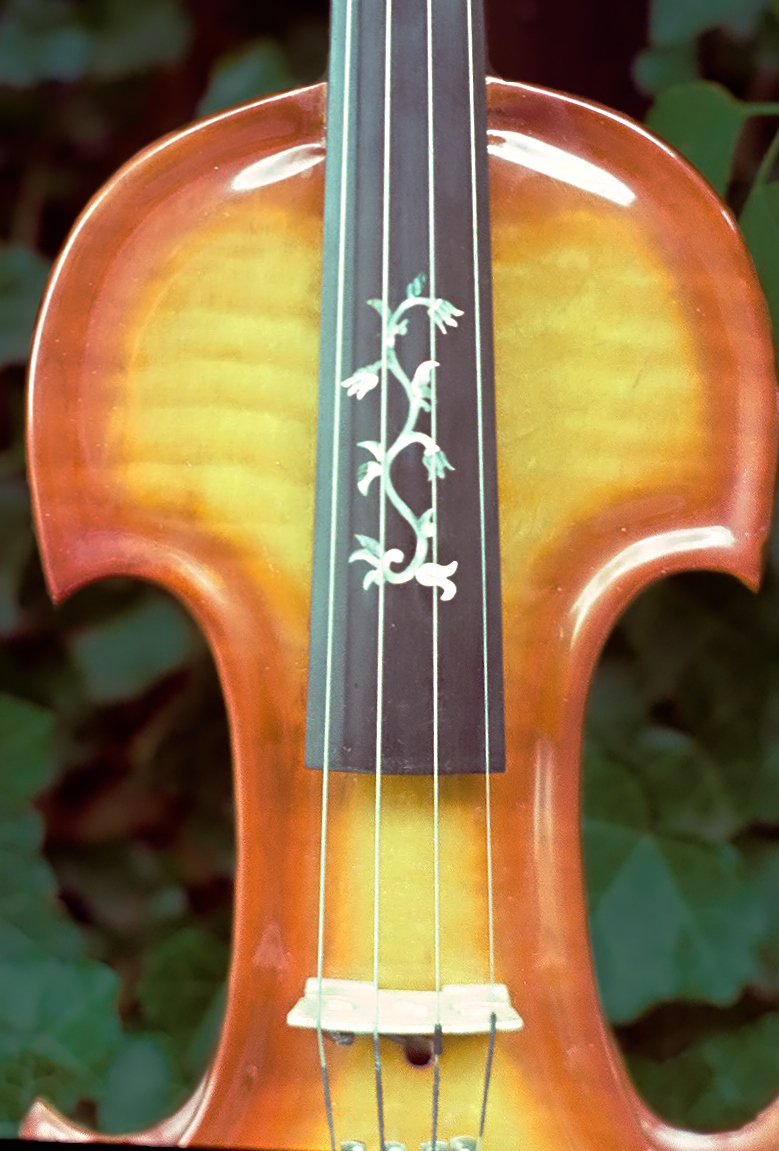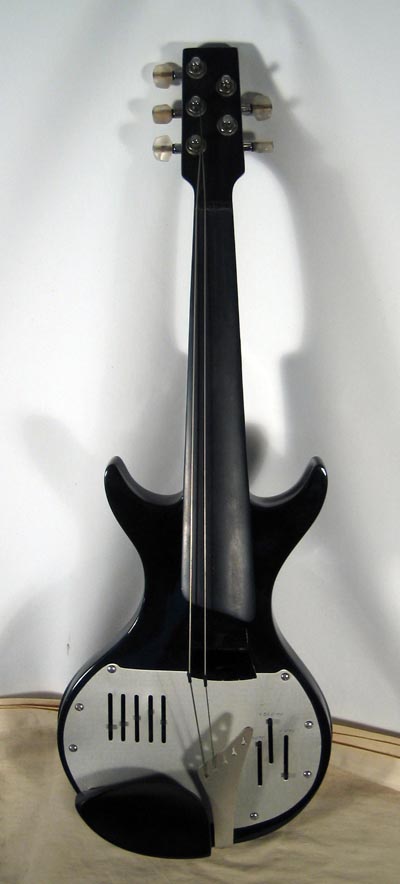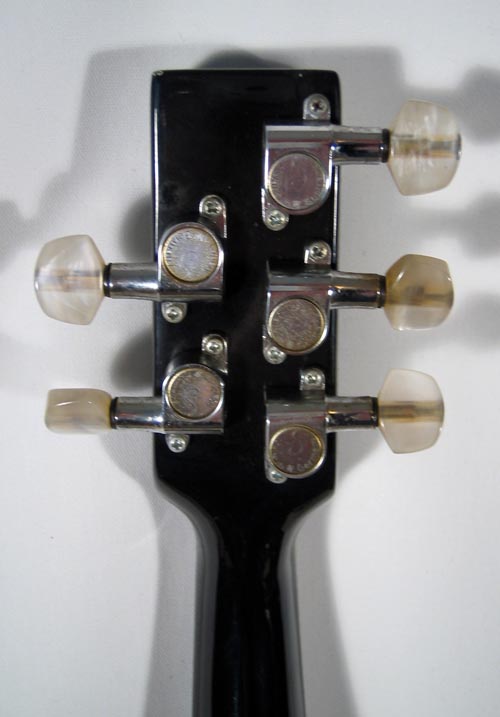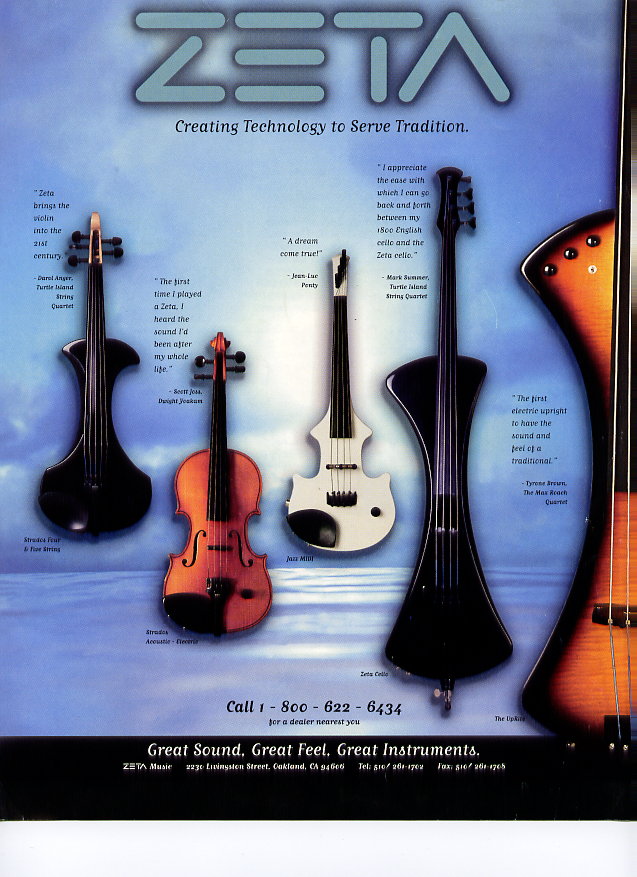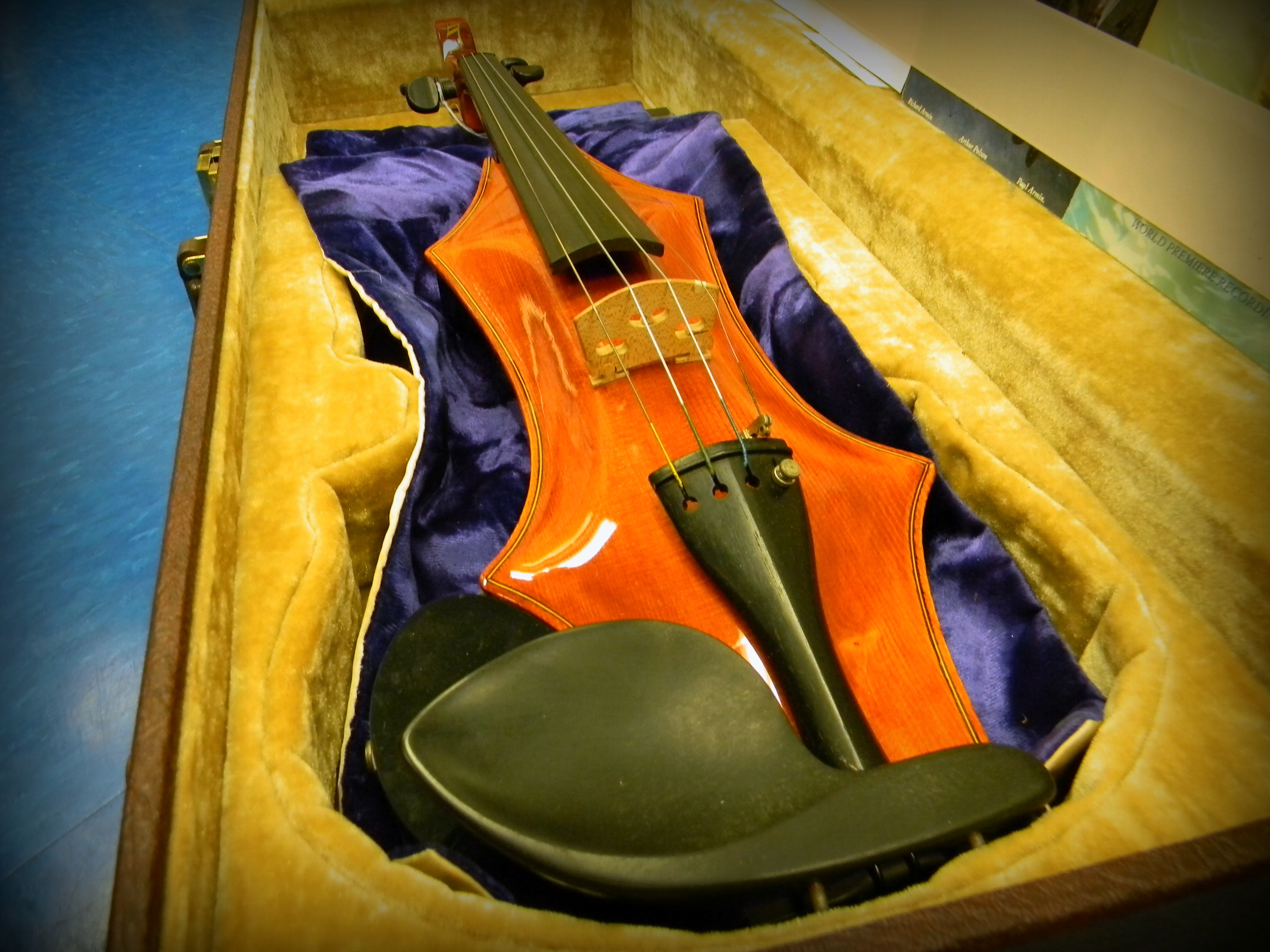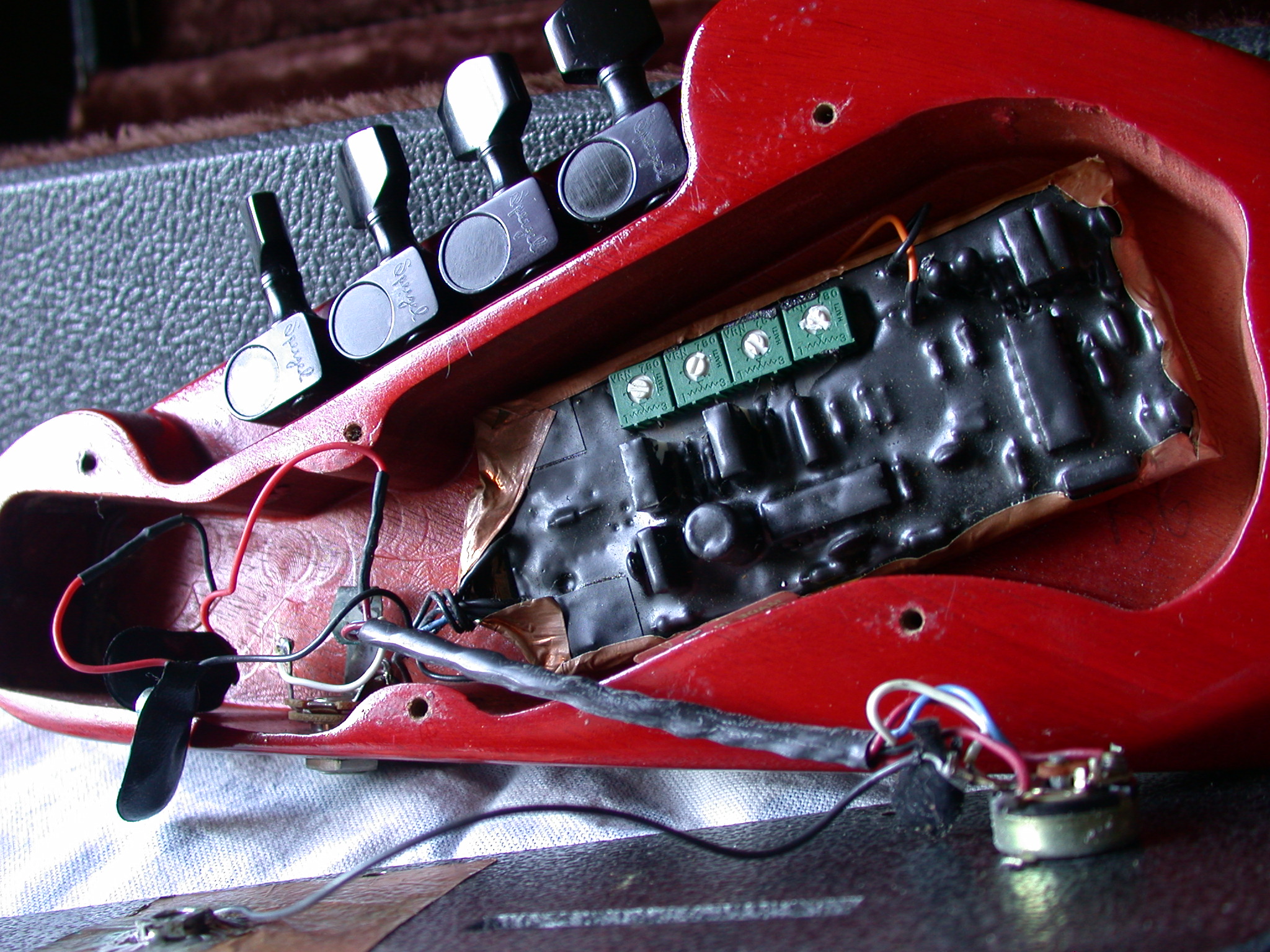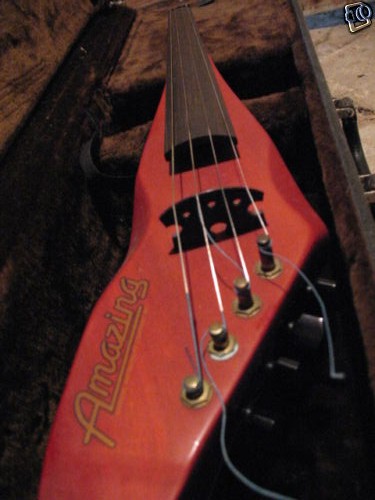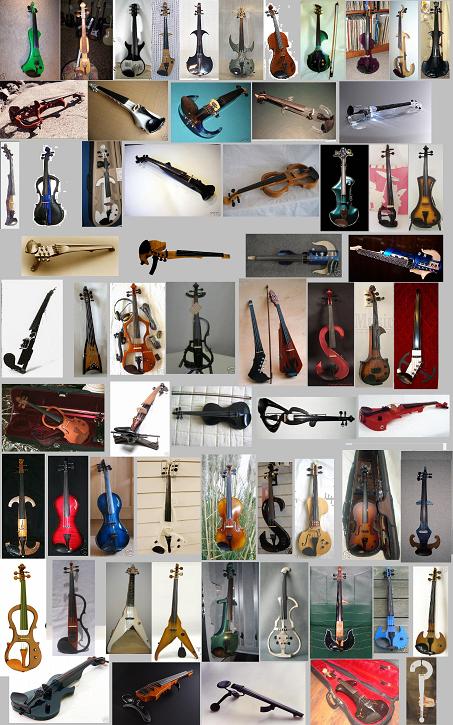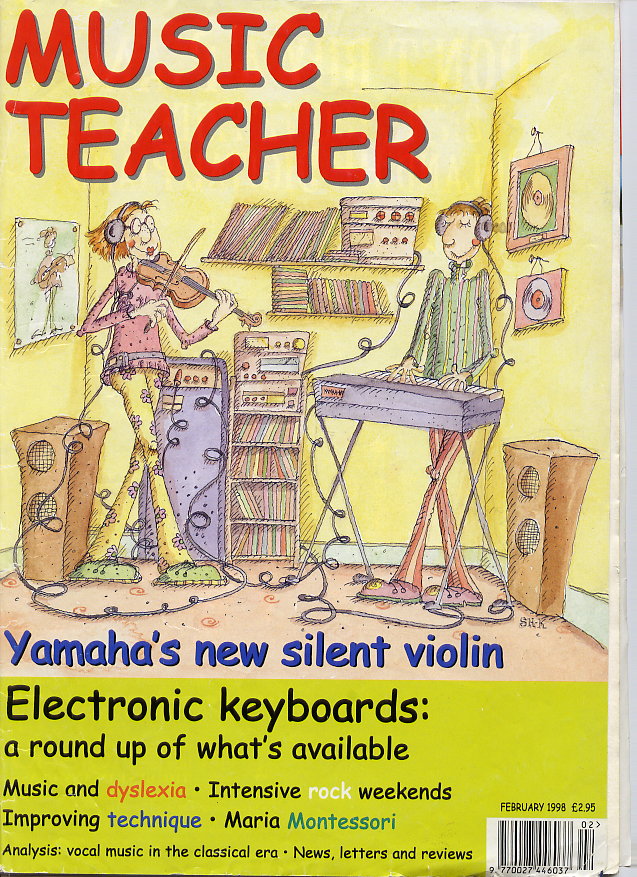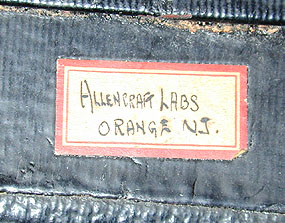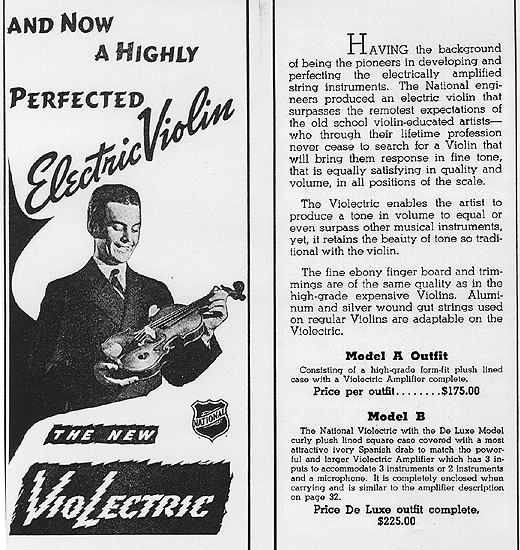click on the tab-titles below to access database entries for known makers of electric violins and devices:
VINTAGE: 1910s - 1940s
J.J. COMER – UK 13th November 1912.
Music is transmitted by a microphone 
31st March 1913 – microphones of the inertia type are mounted directly on the sounding board for transmitting music to a distance
*
W.H. DERRIMAN – UK 8th July 1913
Automatic Enunciator Co. – sound is transmitted electrically. Comer is referred to.
*
A.W. HARRIS – UK 13th April, 1921
 Reproduction of sounds by means of an electric transmission system – as described in specification 144`761{class 40iv}
Reproduction of sounds by means of an electric transmission system – as described in specification 144`761{class 40iv}
*
J.COMPTON. UK 1922
Compton’s story starts here with a sound magnifying attachment. Specifications of inventions by Charles Parsons are referred to. Also an invention by G.C. Marks, an invention for magnifying sound applicable to phonographs and telephone relays is referred to. This also referring to an invention by D. Higham in 1901 classified under Electric Telegraphs for an apparatus for producing magnified sound.
Compton later makes quite a unique claim in a 1929 patent specification. A device is outlined where each string may be individually amplifed using electro-magnets attached to electrical amplifiers and speakers. The described patent is an addition to one granted to Compton between 1921&`23. The earlier patent is described as “the vibrant medium” which the device “picks up”.
*
R.F. STARZL, USA 1927.
 Giant-Tone Radio Violin ( special pickup fitted in the f-hole of a normal instrument ).
Giant-Tone Radio Violin ( special pickup fitted in the f-hole of a normal instrument ).
*
DIMITRIU
Violin pickup invention from France
*
FRANKO – UK 7th February 1930
Electrical oscillations being amplified and transmitted to a sound-producing or radio-transmitting device. Open to inspection see Compton.
*
ALLFORD – UK 20th March 1930
A reverberator for attaching to bridge.
*
Ivan MAKHONINE – FRANCE 1930
*
Paul BIZOS. FRANCE c1931
(several presented c1934 as a complete string ensemble)
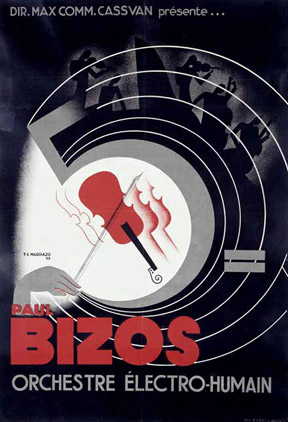 Superviolon special pickup attached to a normal instrument, with associated circuitry that enabled it to play in the ranges of all bowed strings.
Superviolon special pickup attached to a normal instrument, with associated circuitry that enabled it to play in the ranges of all bowed strings.
*
Oskar VIERLING. Berlin, GERMANY c1931.
Elektro-Geige – an electroacoustic violin.
click on the link to see image of Vierling’s violin invention.
Vierling was born in Straubing, Lower Bavaria on the 24th January, 1904. He was a German electroacoustic engineer and instrument inventor. He began to work on acoustics research and the development of electronic instruments at the Heinrich-Hertz-Institute. Vierling’s work on electronic instruments has been divided between oscillator-based electronic organs (and related instruments) and electro-acoustically amplified string instruments, building an electroacoustic violin and cello in 1931.
These instruments are played in the usual way, but instead of the tone of the strings being amplified acoustically by a sound-board, as in the normal instruments, the vibrations are picked up by electro-magnets (one for the fundamental tones and another for the harmonics), conveyed to an amplifier similar to that of a radio set, and issued through a loud-speaker. By manipulation of the amplifier concerned with the harmonics the timbre can be varied; thus the violin can be made, for instance, to sound like an oboe.
(Oxford Companion to Music, 1978)
From searches on the internet it appears that these instruments formed part of an “All Electric Orchestra” and were recorded onto gelatine in Berlin, 1936. The records were recently transferred to CD. Until these recordings are made available the Vierling electric stringed instruments will remain in obscurity.
From the extreme scant photographic evidence available, it appears that Vierling used a “silent” practice violin and attached his pickup device. The similiarities between the body of his electric violin and a known make of silent-violin are striking.
*
A.E. ALLEN and V.A. PFEIL – Orange NJ, USA 1932.
Mr.A.E. Allen & Mr.V.A. Pfeil (both of Allencraft Laboratories, Orange, N.J.) have developed a complete set of stringed instruments (both bowed & plucked) much on the same lines as the Vierling instruments.
(Oxford Companion, 1978)
*
Professor V. KARAPETOFF Cornell University – date unknown.
Five-string cello with amplifier
This instrument is included as a visual record in the Oxford Companion (1978). The cello seems to have no resonating chamber, the body looks like a thin elipse (stick-like) and there is a standard peg-box and pegs. More importantly in one unusual way is that the inventor is seen holding the electric cello.
Dr. Vladimir Karapetoff, professor emeritus of electrical engineering at Cornell University at the time of his death in 1948 was a Russian Electrical Engineer and Educator, born in 1876. His work with electronics dates back as early as 1910 and in 1928, Cornell University published notice of a new five-string cello invention. At the time of writing it is not known whether this instrument included an electrical device.
*
EISENBERG USA 1933
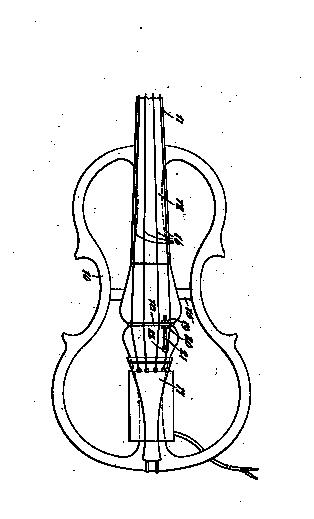 Very little known beyond the Patent information:
Very little known beyond the Patent information:
“The main object of the invention is to provide a simple and efficient means whereby the bowing of a single stringed instrument of the violin type will result in the re-v production of a volume from such an act of several times the amount of sound which would ordinarily be produced from the single instrument.”
*
HENNING. AUSTRIA c1934.
Violin.
No more information currently known.
*
Lloyd LOAR – Acousti-Lectric Co. Kalamazoo USA c1934.
Vivi-Tone Violin.
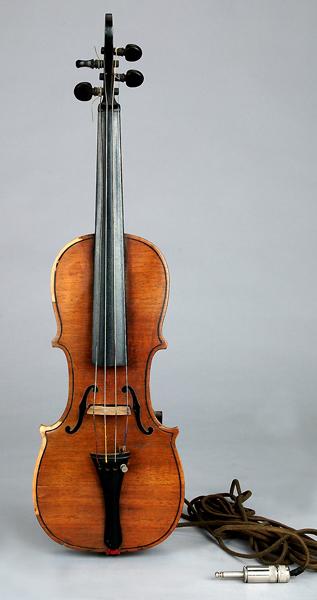
The Vivi-Tone series of instruments by Loar included an electric viola and violin date back to the late 1920s. Loar was successfully awarded a patent for his “Stringed Musical Instrument” on 12 November, 1935.
*
George D. BEAUCHAMP – Electro String Instrument Co. LA, USA c1935.
ElectroViolin – 2 models.
Considered by some to be the single most ground-breaking redesign of a violin and overtly pure-electric instrument, George Beauchamp’s Electro violin is today commonly referred to as an early Rickenbacker violin. This violin was manufactured by the Electro Stringed Instrument Corporation and as such has connections with what are referred to as the very first successful electrified stringed musical instruments. However, as a commercial project it sold a few dozen units and is very rarely seen or heard today.
A few years after launching this violin, Beauchamp redesigned his electric bowed instruments and was awarded patent for a very different design, based on metal frames and wooden necks, launched as the Electro Violin Family. Again though, in terms of commercial success this violin sold even fewer units.
*
INVENTOR UNKNOWN. Padua ITALY c1936.
Violin, audible over 8 km.
This is the most intriguing violin, probably to remain a wonder and quite a frightening thought. Newspaper reports from Padua and the surrounding area might reveal something.
*
John DOPYERA – NATIONAL DOBRO Corp. Los Angeles USA 1936.
VioLectric (amplifonic violin)
*
It is recorded that Dopyera and Beauchamp both thought the other to have stolen their ideas. This cannot be confirmed, although the ‘National VioLectric amplifonic violin’ looks nothing like the Beauchamp model and is specified as being ‘made out of various traditional woods’. Beauchamp states clearly that he thought he had found better alternatives to wood:
… preferably formed of metal, or other material that may be cast in the form of a single part or casting… I have found it desirable to form the body of a synthetic organic substance… (Beauchamp, 1936)
More significantly though, the actual maker of this violin is very probably neither menioned above, but by Fredray Kislingbury.
*
The Violectric (aka National) design follows the traditional body appearance, more so than Lloyd Loar’s viola, without f-holes but with a full-depth and hollow body design. The instruments were carefully made and finished to a high-quality. The hidden electrical device is a horse-shoe shaped magnet and coil positioned directly under the bridge which sits on a sprung plate. These electric violins were marketed for a few years and crop up occasionally on the musical market today.
*
INVENTOR UNKNOWN. USA c1937.
Vibra-Violin.
No more information known.
*
Benjamin F. MIESSNER. Millburn, NJ. USA ? c1937.
Electronic Violin.
Miessner was born in 1890. He was an American inventor and designer of electro-acoustic instruments. Miessner’s first inventions included some connected with early radio research (from 1909) and (somewhat later) electric gramophones. In 1928 Amperite manufactured an electric pickup designed by him for guitars. After selling his radio patents to RCA in 1930 for a large sum of money, Miessner set up a laboratory to explore further the possibilities of electrifying musical instruments. Around 1939 Tom Adrian Cracraft’s All Electronic Orchestra featured several Miessner-designed amplified string instruments.
The violin retains a standard looking neck and stop length and also the extremes of both upper and lower bouts are kept. The pick up is a specially designed bridge – more a block than a bridge. The scroll appears traditionally shaped. The cello looks most radical – completely devoid of bouts but with traditional neck and scroll.
Discussion of this early period in electric violin making reveals the possibility of a legal battle between Miessner and another new company at the time with Miessner being successfully sued for copying copyright inventions.
*
Marshall MOSS and William BARTLEY. Washington DC, USA 1938.
Electrophonic Violin (with belly but no back ).
Moss was a violinist of the National Symphony Orchestra in Washington, Bartley, an engineer. The Moss & Bartley instrument follows the Loar instrument in description, the vibrations being microphonically received through a standard(?) bridge and belly and then amplified.
*
Hugo BENIOFF – California, USA c1938.
Electro Violin, otherwise referred to as a “Seismographic fiddle” owing to Benioff’s work in the field of geology and seismology.
*
KISLINGBURY – USA 1939
Based on evidence found in pickup design the relatively well known VioLectric/Dopyera/Dobro violin seems to be an invention by someone else…
*
AMPEG Guitar Company. USA 1939.
Electric string quartet constructed from clear plastic.
The Ampeg guitar company made an attempt to create an entire family of electric string instruments. These were displayed during the 1939 New York World’s Fair. They reportedly lacked any significant tone quality, were too heavy and weren’t very successful.
*
J.W. McBRIDE – UK 12th December
electrical amplification and instrument
*
H.J. DOWKES UK 18th September 1944
electrical sound magnifying attachments
*
AMPLIFIERS Ltd. – UK 2nd February 1945
An electric pick-up device
*
STANDARD TELEPHONES & CABLES Ltd. – UK 6th June 1945
An electrical arrangement applied to a musical instrument subdivides the frequencies of the notes produced naturally and emits the resultant from a loud speaker.
*
MODERN: 1950s - 1970s
NB: details of makers or reports of electric violins or electrical pick-up devices between the years 1945 and 1958 is scant. During this time the violinist Stuff Smith was performing and recording using a Guarnerius violin with a large metal pickup device positioned behind the bridge.
Clarence FENDER. USA 1951-1958.
Electric violin.
Clarence Leo Fender submitted his patent on 02/06/1958 for an electric violin which was granted in 1961.
“ An object of the present invention is to provide an improved electric violin which may be mass-produced economically and with a very high degree of predictability and uniformity of tone “

Leo Fender’s autobiography records that the electric violin was tried by a few bluegrass fiddlers at a festival in Nashville but although the sound was considered good, the weight ( almost two pounds ) was a problem. Only a hundred or so were manufactured. The project was shelved until the mid nineteen seventies. The appearance of the Fender electric violin combines elements of previous makers. It looks like a “compromise” between having no body and maintaining a traditionally shaped instrument. The main features of the 1961 instrument are the inner-bouts which appear considerably stretched along their length and the scroll which is a miniature classic-Fender guitar headstock. This idea of instrument design can be seen in some of today’s instruments (ZETA and Bridge Instruments).
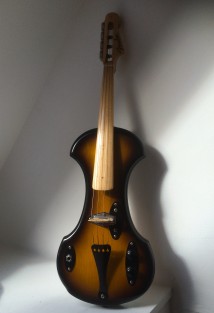
*
Barcus Berry – pickups for all bowed string instruments.
There are different types. One, a small pickup slotted onto the bridge of an acoustic violin, gives a very immediate and accurate violin-sound. Berry are a big company, distributing around the world.
– MORE CONTENT TO COME –
*
Max. MATHEWS. Bell Laboratories, USA 1972.
Electronic violin.
In the early nineteen seventies Max Mathews developed an electric violin with a separate pickup for each string much along the lines of Compton but positioning the pick up in the bridge, under the strings. Mathews and advocates of his violins (principally Negysey) have contributed essentially to the development of an electric violin technique. 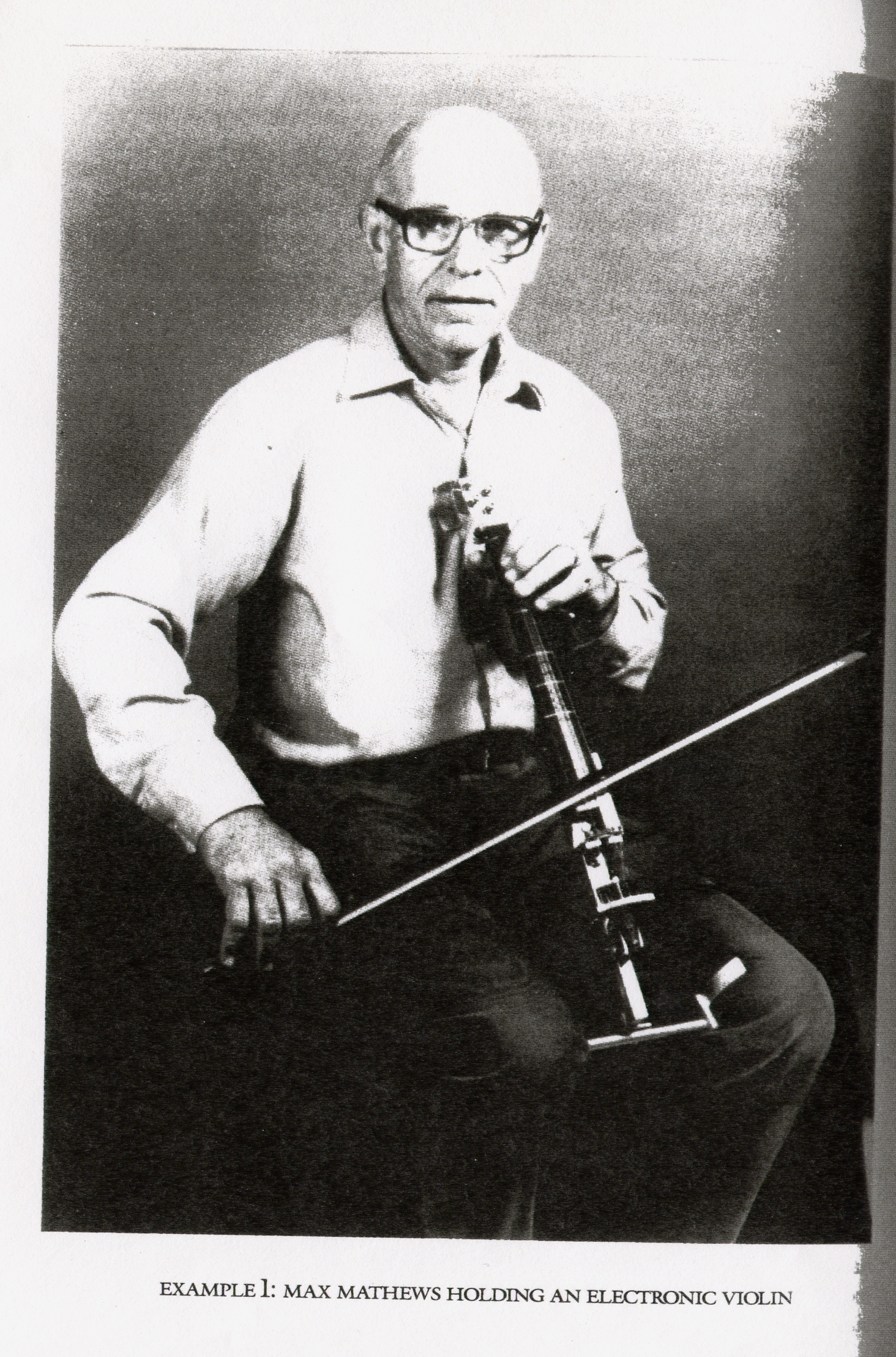
“ In this age of the electrified sound, the professional violinist has been slow in accepting or experimenting with the so called ‘electric’ violin. Part of the problem could be simply with the quality of the sound that it is capable of producing… The problem of the violin as it is today in meeting future musical needs is two fold : first is the matter of supply and demand of fine instruments; second, the need of the modern soloist… the electronically adjusted instrument is worthy of serious consideration by the string world.”
Dr. Eugene Gratovich (1973).
The following is taken from a published interview with Mathews.
“ The electronic instruments all have regular violin strings and they all have bows. So the source of the vibrations is the same as in a regular violin. But thereafter the sound gets modified electronically. It is possible to tune the resonances very accurately, and it is, of course, possible to have as much energy in the sound…”
And from an article discussing a piece of music written specially for the Mathews violin :
“ By merely amplifying the instrument, for example, a world of sound heretofore imperceptible becomes part of the composers palette… Electroacoustic violins have been used quite extensively in performance, although not so much in ‘art music’ circles. Still, given the fact that most serious ‘music lovers’ are exposed to the classical violin literature through records, tapes, and radio broadcasts, in reality the average ‘guy on the street’ turns out to be more familiar with the sound of an amplified violin than the sound of an acoustic one…
All of Mathews’ electronic violins use regular violin strings, and the violinist plays and holds the instrument in a traditional manner. Therefore, like an acoustic violin, the source of vibration and the playing technique are identical. However, there is one important difference. Since no acoustic energy is actually supplied by the vibrating string, as is the case with an acoustic violin, the electronic instrument both speaks faster and requires less bow pressure.”
Richard Boulanger (1986).
*
Ivan DODSON – USA c.1974
Listed contact – 212 Dellview Ave., Santa Cruz, California 95062
In 2015, owing to lack of documented evidence, Dodson remembered his work with an electronic violin:
At the beginning of my career I did create a couple of electronic violins. Using Barcus Berry bridges with crystals embedded in the bridge I altered the shape of the violin except for the neck and the area where the instrument sat under the chin. But, after that I pretty much stuck to traditional violin making. I am a banjo performer and instrument repairman now. My name was included in a directory of violin makers at that time by a researcher from UCSC. Thanks for the contact. There were a number of makers who pursued the electronic violin about the time I was starting my career in 1969. Some of those instruments came through my shop for repairs years afterward, so I was privileged to hear how they performed. I believe I’m still pretty much convinced that there are venues for the electronic violin, but prefer to work with acoustical instruments.
…
My master worked in Chicago for William Lewis & Son, also for Lyon & Healey. As he lived in an apartment building and couldn’t practice with an un-muted instrument he devised a solid body instrument and hollowed it out to lessen the weight. That gave him a practice violin that made very little sound.
When I decided to make an electronic instrument I did something similar. I used spruce and provided the measurements to keep all fingering and chin support as natural as I could. I hollowed it out to make it light enough to have the feel of a traditional instrument. A piezo crystal bridge provided the audio pick-up. It plugged into a small portable pre-amp and from there into any amplifier for control of volume and effects. I did not document any of this…
A couple of innovative young fiddlers at that time used contact mikes placed under the tailpiece of traditional violins and found that to be satisfactory. With the invention of midi connections for the computers sound could be altered to make any traditional violin sound like almost any other instrument simply by running all the sound through a computer. By running loops a single violin began sounding like an orchestra. I rather lost interest in that process and had a preference to the process of building traditional instruments focusing on the study of affecting tonal qualities by graduating the plates in both traditional measurements and the treatments of the woods. I’m certain that by now there are many who have taken the electronic violin to new heights. I’m not a violinist, my pursuits as a musician were on banjo. I have a pretty good understanding of the acoustics of traditional viols so have made my reputation on that. I’m glad that there are other luthiers who are pursuing the electronic end of the industry.
*
R.Kent ALBIN – USA c.1975
Last known address – 1458 Haight St., #1, San Francisco, Calif., 94117
– CONTENT TO COME –
*
Electro String Instrument Corp. – USA c.1976
Listed as makers of strings. Last known address – Box 1321, Santa Ana, California 92702
*
Robert J. WILLCUTT – USA c.1974
Previous contact – 443 S.Ashland Ave., Lexington, KY. 40502
Current: CEO/Master Luthier, Wilcutt Guitars
As a young man in his mid 20s, Robert, “Bob” Willcutt, made an electric violin “from scratch” in or around 1974. The violin was commissioned as a gift for a concert violinist to try something different. In 2015, Willcutt located (the only) photographs of his violin and was able to provide the following information from recollection. At the time of writing the whereabouts of this electric violin is unknown.
The violin was crafted from one solid piece of Kentucky curly maple, the only hollowness was a long hole drilled through the jack hole to where the pickup wire went near the bridge. Inlay was designed and done by Willcutt’s former wife, Anne Sheen who worked with him at the time. The pickup was a Barcus Berry (“hot spots”?), at the time considered by Willcutt to be the best choice coupled with their (“redbox”?) preamp. The jack was on the bass side of the instrument so the cord would go over the player’s shoulder. The sides were cove cut so when viewed with the top contours, it looked like a violin’s edge lip, but it was all one piece of wood. This carving of the sides, to make solid wood look like the lip of a real violin but still be all one piece was the hardest part in making the electric violin. It played and sounded fine when a preamp was used.
This is the only electric violin Willcutt made. He has created a Brazilian rosewood autoharp, 75 or so dulcimers and countless electric guitars of different levels. Most have been sold.
NB – The images here are provided kindly by Wilcutt for Deltaviolin and thought to be the first time they have ever been seen since the instrument was made four decades ago.
*
XINDE International, Inc. – USA c.1978
Last known address – Walker Dr., Upton, Mass. 01568
Manufacturer of the Vi-tar or Vitar electric violin.
According to Patents, this extraordinary electric violin was invented by Spencer Lee Larrison and filed in 1970. The Patent was granted in September 1972 at a time when the Fender Electric Violin had been relaunched.
RECENT: 1980s
Since the 1980s the electric violin has grown to be more widely used and possibly even respected instrument. Here are the real roots of the first commercially successful electric violins.
ZETA Music Partners. California, USA c1980.
 In recent years, as a company ZETA folded and the original prime-movers Richard McClish and Keith McMillan went their separate ways. However, in 2015 the company was bought and relaunched starting a new chapter in the life of one of the niche-end violin products on the market… the following was written before the company folded:
In recent years, as a company ZETA folded and the original prime-movers Richard McClish and Keith McMillan went their separate ways. However, in 2015 the company was bought and relaunched starting a new chapter in the life of one of the niche-end violin products on the market… the following was written before the company folded:
Zeta are a major company in the manufacture of bowed electric instruments. Possibly the biggest company to emerge from this period. They now supply different models suiting many types of music – Jazz, rock, country, pop, avant-garde, traditional folk, etc. A Zeta pickup comes with the choice to use digital technology – MIDI (Musical Instrument Digital Interface) – ensuring the Zeta sound can be found in underground and mainstream dance music. It is difficult to conceive of an earlier digital violin. In the 1990s it was been advertised heavily as an ideal educational tool. American String Teacher and The Strad magazines regularly run an advert. Zeta is also by far the most expensive electric instrument on the market. A custom built, MIDI instrument costs about £3000.
“Strados” and “Jazz” model violins, violas, cellos and basses (both types upright and slung, recently a “cross-over” instrument) are all manufactured by Zeta as well as spares and processing equipment.
One of their models in the Strados series looks like the Fender instrument, another in the same series being like the National VioLectric. The Jazz model looks the most radical – with a slim rectangular headstock, weird flat, upside-down-skull shaped body and lack of tail piece – Zeta claim that this instrument design “facilitates reach to all positions and increases playing speed”. The neck length and stop remain true to tradition as “important positional cues… retained to ensure familiarity of play.”
Zeta music partners keep the workings of the technology used in their instruments and pickups a closely guarded secret. The bridge design has two small copper-coloured plates set at right angles, across which each string is drawn. It is a device obviously based around the Mathews method of pickup. Each string can be connected to separate circuitry and speakers if desired. The sound is definitely electric, somewhat off-putting for someone looking for a wooden sound. But I think that it is this aspect that stands Zeta apart from all others. The sensitivity that the pick-up works at is almost blinding.
In their pickup, Zeta claim to have invented a device which defies the common problem of feedback. The reality of this statement depends entirely on whether an instrument with a resonating body is used. Great problems can still be encountered on stage due to feedback, a problem which seems solved when using the same pickup on a solid bodied instrument.
– UPDATE & MORE CONTENT TO COME –
Richard ARMIN – Raad Instruments Incorporated. Toronto, CANADA c1984.
Raad electric violin.
Armin received high acclaim from the classical violinists magazine, The Strad. He and a team have produced an instrument that although shaped differently retains important aesthetical points. The pickup device used in the instrument is designed by the Raad team and is considered sensitive to the complex mechanism at work in finely crafted vibrating wood, yet it is designed to withstand the problems of feed-back.
“the most important implication… is one of ‘user responsibility’. Armin-Riley claims one can virtually ‘set the personality of the violin’. A generous violin, it lends itself to control of intonation, control of articulation and technical facility, for example easy reach in the higher positions.”
“Recent testing has illustrated quite clearly that the Raad violin has a dual performance capacity – as a solo instrument and a group instrument. As a solo instrument, Richard Armin claims this violin will allow for a return of the violin to a prominent position. Quite simply, it has, he says. ‘up front’ quality. Its capabilities will allow the string sound a return to the spotlight. Yet, in a band the instrument achieves equality with the rest of the instruments with no sacrifice to any one sound element. It can find its place balancing with winds and electronically amplified keyboards. This compatibility factor makes it ideal for pop music and back-up band music. The violin could influence the direction of pop orchestration as emphasis shifts from technician to musician with the player being in control of the sound quality.” Marilyn Emerson (198?)
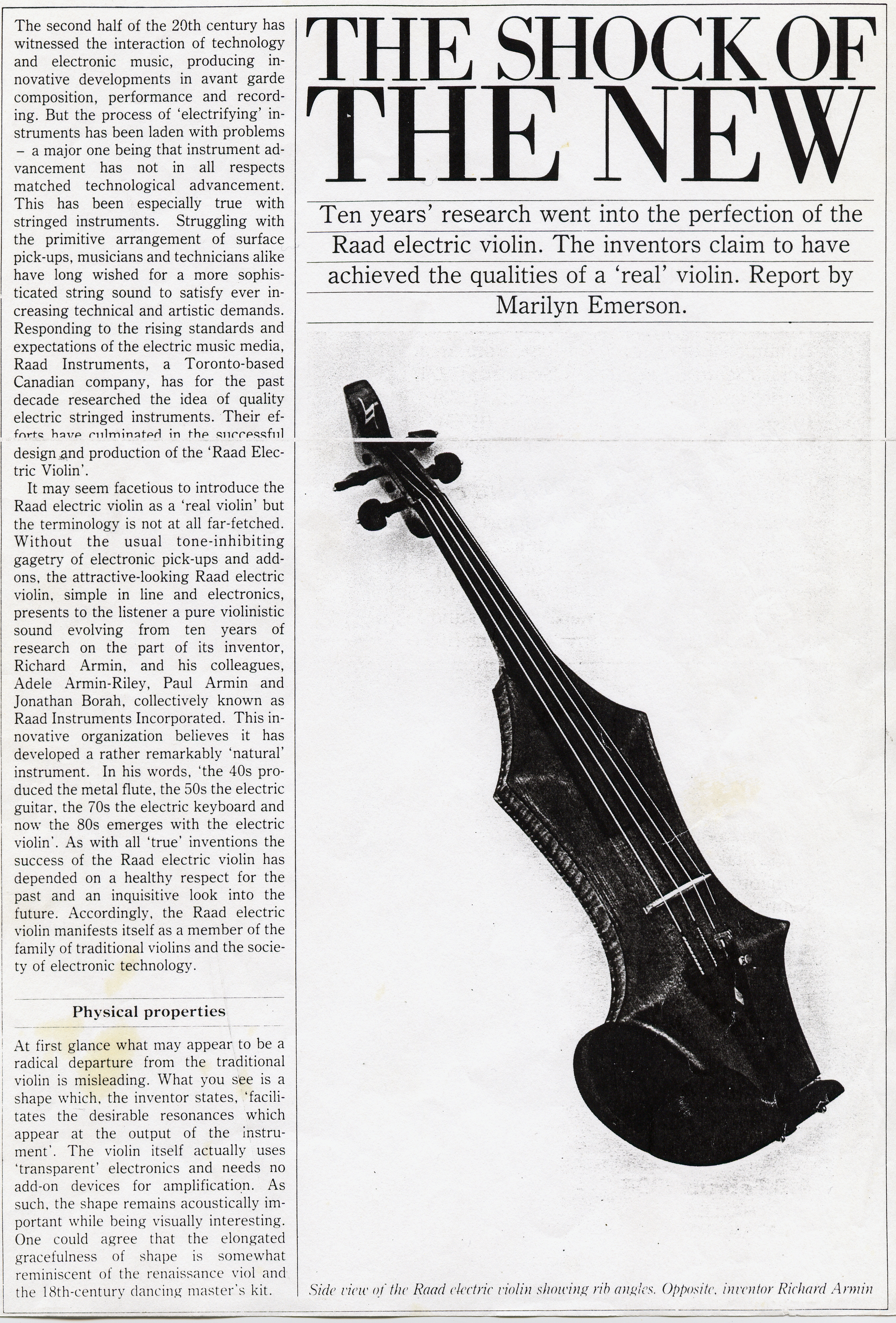 – MORE CONTENT AND UPDATES TO COME –
– MORE CONTENT AND UPDATES TO COME –
*
Amazing Electric Violin, early to late 1980s
Made in Canada.
A most ergonomically designed musical instrument; the Amazing Electric Violin.There appears to be little collected information about these violins. However, an example of the violin can be seen in an exhibit at the Architecture & Design department at the Museum of Modern Art, New York.
From MOMA’s information only a little can be gleaned about this dramatic piece of Lutherie. The instruments appear to be the result of the collaborative work of David Bush, Brian Lepine and Michael Zimmerman. Another figure, Scott Carroll is found in connection with the formation of the Amazing Company. The instruments were manufactured by Bridges Musical Instruments.
The now defunct “Amazing Musical Instrument Company” was based in Toronto, they made some waves with electric violins in the 1980s and also made a few mandolins, guitars, bass guitars, cello and bass too. Mention of a design patent for “the world’s most ergonomically correct violin” has not been substantiated. The company folded in or around 1989.
The following information is found on an old website connected to the involvement of Scott Carroll in the company and is included here as found:
“A Whole Line of Musical Instruments…
In the early eighties, Scott Carroll was one of four founding partners and a key-man in the Amazing Musical Instrument Company. This was one of the first companies to offer the public a truly electronic violin, and a whole line of stylish electronic instruments paralleling their classical counterparts. These instruments were hand-crafted by Michael Zimmerman, a well-respected and seasoned luthier, out of ideal exotic woods to stringent specifications, producing superior base timbres. The proprietary internal tone contouring circuitry and pickup system was designed by Brian Lepine, while production and quality control was carried out by David Bush. Marketing and Sales was handled by Dell Herter. This unique team took the company from the drawing board to capacity production in one year, raising six figures in investment capital from both the government and prestigious members of the private sector.
Complex Engineering and Musical Subtlety
The design problems were new, unique, and challenging. The team assembled was fortunately very experienced in both the scientific and musical side of the many aspects of the problems they took on, being accomplished musicians to a man. Mr. Carroll’s contribution to the engineering side involved analyzing and duplicating the complex behaviour of a real violin bridge on a solid-body design. He had to ensure the coupling and transmission of pure sound quality from the strings, bridge, body, patented resonant sound cavity and sound recording components. Carroll also supervised and assembled key components and circuits, protecting the proprietary nature of the designs.
Voila!…
The result of the team’s engineering efforts was a line of instruments still carried today by major music stores in Canada, such as Long & McQuade. Although the company has since changed hands, and the team has moved on to other projects, the instruments have earned themselves a place of respect in the history of new musical technologies, and are valued by collectors.
Plagarism: the Highest Praise
Our essential engineering and design was so accurate and solid, that large companies like YAMAHA MUSIC waited twelve to fifteen years, then imitated us closely, from the bridge coupling and pickups, to the body cut-outs, and even down to the rich dark brown gloss finish!”
*NB – CONTENT AND MORE INFO TO COME
*
FISHER Industries Incorporated. Geneva, Illinois, USA c1984.
Lectrolin.
The Fischer violin follows the Beauchamp model in appearance being described as having an unusual pyramid shape. It is also available in a 5 string version.
– MORE CONTENT & UPDATE TO COME –
CURRENT: 1990s - 2010s
Current *at the time of writing 1996-1999
TODAY’S INSTRUMENTS
“Sound and Vision in Harmony”
Ted Brewer (1998)
There are a growing number of manufacturers of electric bowed string instruments. Below is an incomplete but rapidly expanding list. Some are becoming well established. The majority of the following are supported with a picture. I have also played a few of the following. Because these makers are around today the list is set out alphabetically.
NB – IMAGES, UPDATES AND MANY ADDITIONS TO COME –
ACHIEVE InstruMENTS – Andy Holliman
Hawk electric violin
Raad/Miessner type, crafted wood. Talon like scroll and part resonating body. Andy makes traditional string instruments also. He is a Newark-qualified luthier and plays and writes fiddle music. His electric violins come with Zeta “Strados” bridges or Jazz series on request. I tried some of his electric violins and discovered ZETA through a meeting at his house one day.
*
Barbera Transducer Systems
pickups for violin, viola, cello and bass
“A multi-element pickup cartridge design (patent pending, 1997), made of rosewood or maple, set in a maple bridge. The pickup cartridge contains an array of independently mounted piezo elements – one for each string. Each element within the cartridge structure functions as an independent pickup which is highly sensitive to its corresponding string’s horizontal vibrations. This is the plane which the bow travels, and where all the rich complexity of sound occur on a bowed string.” information from T.F. Barrett Co.
*
T.F. BARRETT Co.,Westminster Station, VT, USA 1997 (1982)
Electric musical instruments
Located in Southern Vermont, involved in the research and construction of electric violins, violas, cellos and associated hybrid variations. Barrett’s first violin (the EV-5) was an acrylic instrument designed as a highly visual stage instrument. By January 1997, two forms evolved: acrylic and wooden. Barrett write:
“ The thin top and back plate are suspended across a span that allows specific movement of the plates to give a more open (acoustic) sound to the instrument… The acrylic plates are tonally inert yet offer a unique projection platform. This provides an unbelievable presence and lets the pickup work to its full capacity… Both the wood and acrylic models come equipped with Barbera Transducer Systems pickups as standard equipment.”
*
Warren BOND Enterprises. Worcestershire, UK 1996.
Electronic Strad.
Beauchamp-type, crafted wood. Anchor shape with Ashworth bridge pickup.
*
Ted BREWER Violins, Sheffield, UK 1998.
Since appearing in the late 1990s, Ted Brewer has successfully developed an acrylic based electric violin, known as the Vivo. His work has gained serious attention from players and he is firmly established as one of the leading makers of a range of violins in the world today. His design and finish has evolved from a most basic point, every part of the violin has been studied and the end product is very much a fresh and exciting instrument.
NB* UPDATES & CONTENT TO COME
The following was written in c.1998 and will be re-written as soon as time allows.
Stealth, Revolution – electric violins
Beauchamp-esque. A very exciting looking instrument. Radical design (similar in someways to the Stingray – see Starfish designs below). Purely acrylic and mixture of wooden elements. This is how they are described in the advertisment:
“Individual hand crafted electric violins. Specifications of any instrument you may be used to playing can be copied.”
Ted Brewer’s violins are in a different class altogether. With the advice and help of violinist Jay Brittain (Royal College of Music London), Brewer’s violins are confidently electric.
Playing them is something else. The vibrations are acutely felt through the instrument, very responsive and so original. Ted is a wild person channeled through a very sensible head. He has swiftly moved from a self professed innocence to a passion to create the whole quartet. Since simple and humble beginnings, working very much from home, Brewer’s instruments are now manufactured on a significant scale.
*
Bridge Musical Instruments, Lincolnshire, UK 1996. c/o Esther TAYLOR ?
*NB UPDATES AND CONTENT TO COME
Aquila, Lyra, Draco and Cetus – electric violins, violas, cellos and basses.
Fender type, thinner and hollow, moulded carbon fibre with traditional wooden neck, finger-board and tail piece.. Piezo-pickup device used was designed for the instruments. Surprisingly deep, rich tone for a mainly non-wooden instrument (the first non-wooden violin that I have tried admittedly). The instrument is light–weight and very comfortably balanced. There is a new model now featuring slight changes to body design.
*
Paul C CLIFF. Manchester, UK 1995.
Crossbow electric violin.
(Strong) Miessner type, almost identical in uncustomised-state, crafted wood. Stick-like with Ashworth bridge pickup and electro-magnetic pickups designed by Paul Cliff. Custom builds to order. One model mounted with 4-string Zeta pickup, neck stop length extended by graduating the stop rather than using the traditional right-angle. There is no upper-bout certainly allowing much freer access along the string length. The scroll is after the plain electric guitar headstock (flat, rectangular, with four machine heads). It is reasonably heavy.
Cliff no longer makes musical instruments.\
*
FRAP – pickup Frequency Response Amplitude Pickup
*NB CONTENT TO COME
*
Frontline
Piezoelectric pickup
JENSEN
*NB UPDATES AND CONTENT TO COME
electric violin
Beauchamp type, crafted wood. Stick-like, looks like one long neck with a reduced neck stop. A very slender instrument. The underside of the neck traces a line which brings it to not much below the bridge. On a traditional acoustic violin, if the neck were to continue at the same degree its underside would meet the feet of the bridge. A natural alteration of one of the significant standard features of many violin type instruments? In the Jensen violin the fingerboard not so much ends, it falls away near to the bridge. A very beautiful looking instrument.
*
Neo Designs, Emma NEWTON
*NB CONTENT TO COME
Electric violins
Almost identical to the Strados Zeta violins.
Available from Potters Music Shop Ltd., 12-16 High St., Merstham, Surrey RH1 3EA
Oakwood Instruments. Leeds, UK 1997.
*NB UPDATES AND CONTENT TO COME
Electric instruments – including Bouzoukis and Citterns
The violins come as various stringed options. All are of the Beauchamp (first) type, crafted wood. Stick-like appearance with Ashworth pickup, traditional neck and stop. No shoulder bout. Similar to the Jensen violin.
Polytone – pickup
No more information known
*
Andrew SCRIMSHAW. London, UK 1996.
Electric violin, viola and cello.
(Weak) Beauchamp/ Miessner type, crafted wood. Axe shape, with shoulder bout portion. Another electric violin using Ashworth bridge pickup.
Skyinbow – Shetland Isles, SCOTLAND c1992.
*NB UPDATES AND CONTENT TO COME
Electro acoustic violin.
Loar type, crafted wood. No f-holes, acoustic body design and traditional bridge with Fischman pickup.
There are different models, one being a cross between a skeletal instrument and a Loar type design avoiding some of the feedback problems associated with other electrified violins. Although very much like a traditional instrument, some early Skyinbow models are slightly heavier.
The first Skyinbow instruments suffered from the problems of feedback, but played in suitable settings, within a certain volume range, the instrument has a powerful and immediate, traditional wooden tone. The design and finish is bold. The scroll maintains the traditional peg-box but tapers away rather than curl up. The body of this instrument is so responsive that even with the ZETA pickup in place the instrument still had severe feedback problems at volume. Another draw back, contradicted in the advert is access to the internal workings. Repair work is almost impossible being confined to one ‘key-hole’ entrance. Without drastic measures – e.g. cutting through the finish to access the pickup – this is something that better relies on not going wrong.
Since the first models, Skyinbow have developed their range of instruments and have become one of the leading manufacturers of electrified violins on the market today. They are a popular choice.
Starfish Designs. Mike ANDERSON – Inverness-shire, SCOTLAND 1990.
*NB UPDATE AND CONTENT TO COME
Vaguely Beauchamp-type. Skeletal/anchor shape design. The photos of the violin and cellos offer the electric violinist a stunningly attractive instrument to play.
Stingray, Octopus, Dolphin, Barracuda are names given to the different instruments of the family of bowed strings. Beautifully, customised, hand-built instruments. Unfortunately being located by Fort William, Inverness-shire poses some considerable logistical problems. These look like they are worth the trip! At a glance the instant visual feature is the holes running the length of the body to the neck. These instruments look like they are made from wooden mechhano and have attractive appeal being charming to the eye.
Specifications and details obtainable directly from Mike Anderson describe an instrument that is undoubtedly of a high quality, trustworthy performance and remarkable value. The only element of this instrument provided by anyone other than Starfish is the fitting of the electrical components. Again the name Ashworth appears.
One source describes the sound from the view point of the instrument maintaining versatility, a good tone and a pure sound in both quiet and loud volumes.
Ned STEINBERGER. Nashville, USA c1996.
*NB UPDATES AND CONTENT TO COME
VZ5 Electric violin.
In terms of creative thinking, consistency and originality of idea this electric violin one of the violins of the next millenium. In terms of competition there is really very little. Ted Brewer immediately springs to mind but in a different way. This instrument has endless potential.
Arguably, the only violin to abandon every traditional, visual and physical reference to violins beyond being strung with strings and played with a bow. The early instruments seen in photographs look like short sticks connected to a padded tripod. There is very little at a glance that would reveal Steinberger’s design to be a violin. It is loosely of the Beauchamp#1 type – mainly that it is made from a chemical/synthesised compound, is stick-like, without a scroll and the “pegs” (high-tech dials) are located behind the finger board. A ZETA 5-string pickup system is used in the earliest models seen.
Dazzlingly different. The neck-stop and upper-bout are removable, allowing complete unrestricted access to either end of the string. The whole body in some models stops short just beyond the bridge. The body is suspended by what looks like a curved metal bar connected to the second and almost unique feature – the support mechanism: a tripod, comprising a chin rest, connected to two feet. One foot “stands” on the players chest the other on their back.
From recalling correspondence with Steinberger at the time there were no four string versions and the instruments were designed completely around personal specifications. Only about five examples of the VZ-5 were made. One of these made for the International Artist, Laurie Anderson and another, from photographic evidence seemingly for Michał Urbaniak. The support structure is designed so as to isolate the vibrations to be amplified. The only support mechanisms looking and working in this way were invented over 100 years ago. As discussed, there are many patents for methods of supporting the violin. On February 5th 1889, the patent as granted to Lake for a violin support. Basically, it’s “an arch which spans the top of the chest.” One of Steinberger’s violin is supported by a similar looking device. This design in practice gives unparalleled support and steadiness in holding the instrument. In 1996 no instruments had been sold in the UK. With a price tag at $3000 in 1996, it was one of the most expensive instruments on the market.
The following is from taken an interview with Ned Steinberger by Max Kay, 1996. This is an unauthorised and edited version of the interview but as it offers a valuable insight into the mind of a contemporary electric violin maker, hopefully it can remain here as fair use:
“ The key to approaching design is to understand the basics… Simplicity, and understanding of the issues involved, determine the necessary performance feature of a product. You have to isolate the particular attributes and problems of the product being designed. With both furniture and musical instruments the object is creating something that works well with the human body; human engineering or what’s known as ergonomics. A musical instrument has to perform technically at a very high level. Visually it has to be exciting to people. The looks of the instrument cannot be underestimated. The way it looks affects the sound, because it has an affect on the psyche of the artist who is playing it. It is a very functional element, the way an instrument looks, the way it feels, the way an artist responds to it…
Convincing people of the attributes of high-level design can be hard, yet communication through design is one of the strongest bonds between manufacturer and end-user.
Much of my work is speculative; I become interested in certain ideas and then, after the design is developed, I try to connect with the right company to exploit it. For me, this is the hard part! I much prefer to spend my time at the drawing-board.
I also work for companies that have contracted with me in advance. This is great, because the work is directed to specific production and marketing goals from the start, and the collaboration can often head me in new directions that I would not have found on my own…
These products develop, not from sitting down for an hour and coming up with an idea, but through a process of evolution. It’s a lifetime commitment to make things that sound better, look better and play better…
I’ve been working on violins now for quite a few years. Steinberger Sound offers a violin that I designed for them. I initially started making fretted instruments, basses and guitars, then I moved into this violin and upright electric bass. Whenever I have designed an instrument I am always interested in maximising performance. One of the things that I learned the hard way is that it’s difficult to get a good bowed sound out of an electric pickup. To me that’s a challenge… I want to make optimised products…
This brought me into understanding what is important about a bowed sound and how it can be picked up. As a result of focusing on that, I have developed a new pickup, with patents pending, called a bi-polar, which has a great plucked response. I’m at a point now that I’ll be concentrating on a full range of bass, cello, viola and violin. So far, I have the violin highly evolved, the bass is ready, the cello is the next one for me to focus on. I’m really excited about this project…
There is a common concept in terms of the way the bridge is made, the way that the bowed sound is picked up, there is also a commonality of style between them. As I said earlier, the style is very important. It is challenging to design a unifying look for this family of instruments. Particularly so, since the cello and bass are supported on the floor and held vertically in one fashion, whereas the violin or viola are supported on the shoulder and played in a completely different manner. “
Since the early 2000s, Steinberger has redesigned his series of instruments and successfully launched first the CR series of electric bosed strings, then the WAV and more recently the NXT series. These are highly customisable instruments, including fretting. Steinberger is promoted as the most eminent maker of electric violins in the world today.
*
Underwood – pickup
*NB CONTENT TO COME
*
Vector Violins – Nicholas Tipney, Canada 1996
*NB CONTENT TO COME
A Beauchamp type electric violin in appearance but nothing more known beyond regular advertisements in the Strad Magazine during a few years.
*
Violectra. . David Bruce JOHNSON – Birmingham, UK 1990s
*NB UPDATES AND CONTENT TO COME
Electric violins, violas and cellos.
There is little doubt from the customer list accompanying Violectra that here is a success story. The name of Violectra is a registered design and trademark. In June 1996 David Johnson’s Violectra was pending patent. A very popular instrument which is custom built to order. Nigel Kennedy is often seen using Johnson’s violins and Ponty, Swarbrick and Hartley have given Johnson their seal of approval through commissioning instruments for themselves.
In appearance the Violectra loosely follows Beauchamp’s Electro#1 in locating the tuning pegs (machine-heads) behind the bridge. Johnson uses crafted wood and a skeletal-frame design finished in a variety of colours. As described by Johnson as innovative the wooden-frame construction is striking and looks sturdy.
From a technical stand-point the pick-up mechanism used on the Violectra incorporates a piezo-crystal device under each string, the signals of which are combined and passed to a socket underneath the instrument.
Violectra’s success appears to be based on the claim that this is an electric violin that sounds and responds like an acoustic violin. This perceived ideal might stem from Johnson’s experience with customer demand but it is not necessarily a sound argument for the electric violinist. Without doubt, Violectra is one of the few long-term success stories in manufacture and sale across the world.
*
Mark WOOD
*NB CONTENT TO COME
*
Yamada
*NB CONTENT TO COME
*
Yamaha – Silent Violin
*NB UPDATE AND CONTENT TO COME
Although in many ways this the first electric violin to break-through to the mainstream market is a very exciting development for the credibility of the subject, the first Silent Violin was far from the best electric violin.
“The first discovery was that it is not silent… it is heavy… Armed with the manual… I could more confidently… discover the sounds it produced… though it does not require any special skill to play the instrument.”
Jennifer Paterson – Music Teacher, February 1998
The silent violin, according to another article “ a very attractive instrument despite, its unusual cutaway design, though the overall dimensions, neck and bridge are exactly like a conventional violin. This means it immediately feels entirely comfortable for the player and, moreover, is equally suitable for the playing technique of a classical or folk violinist.”
Tony Cliff – Yamaha Education Supplement, Autumn/Winter 1998
Yet, this first instrument was flimsy and probably easily breakable. The plastic and wood mixture looked ugly. What is the reasoning behind the half-body appearance, what purpose did it serve and why not make it removable? If it were removable the Silent Violin would immediately look very much like a Beauchamp Electro violin#1. There is an immediate and striking resemblance to the Makhonine electric violin from c.1930 yet Yamaha reps claimed no knowledge at all of these early instruments. An affordable electric violin made by a big company, this violin also features a solid shoulder support mechanism. The shoulder-rest device screws into the body of the instrument and once there it is unlikely to fall off – the bane of violinists who rely on support mechanisms. The Yamaha Silent Violin is a stable violin then and with continued development and now with a wide range of instruments from entry level, through student to professional and concert models it has successfully established a significant presence on the world market.
The Origins and Development of Electric Violins
The radical Allencraft Labs Electric Violin by Victor Pfeil are about as early as records really begin in 1932; Lloyd Loar’s electric violins appeared as a Vivi-Tone instrument in the early 1930s; George Beauchamp’s Electro Violin from as early as 1935, one of a few dozen ever sold; and Fredray Kislingbury’s Violin appearing as the National brand VioLectric. All only ever sold in very small numbers from an as yet unknown quantity. They sporadically appear on the musical market and promptly disappear again.
Specially designed violins with built in pickups and associated circuitry had reached public awareness by 1930. Then, even if only on a very small scale, makers such as Victor Pfeil; Lloyd Loar; George Beauchamp; and Fredray Kislingbury all made electric violins that were manufactured – by Allencraft, Vivi-Tone, Electro String Instrument Corporation, and National. Of these only two, the Electro Violin and the VioLectric ever reached something vaguely like prominence.
Kislingbury’s violin appeared under the National brand that was advertising as being ‘The Worlds Most Famous Electric Amplifying String Instruments’. Appearing by 1936, this violin was called the VioLectric and at a glance looks like a traditional acoustic violin. The name is very similar to the current ‘Violectra’ (by David Bruce Johnson from the UK) but is a completely different violin. It could also easily be confused with the later re-released Valco electric violin (via Dopera et al) from the early 1960s.
The Beauchamp violin appearing around the same time as the Kislingbury was a completely different instrument. Formed from Bakelite and heralded in advertising as a Miracle by the Electro Stringed Instrument Corporation, it was branded as the Electro Violin. For the interested, this is an infuriatingly rare violin – maybe less than 60 were ever sold before the early 1940s. The stick-like minimal frame, bearing more than just a passing likeness to particularly the Jordan electric violin, makes Beauchamp a real pioneer in this field, and in the second incarnation of this instrument in 1943 shows a very obvious similarity to the Stroh-violin from 1899…
There is a great deal more to the Story of the Violin and some of the instruments are yet to be found, maybe even in a dusty old case under the stairs! Hopefully and one day soon one of the instruments definitely missing from the above links will emerge… until then the Hugo Benioff, Quake-inspired Violin appears lost in time.